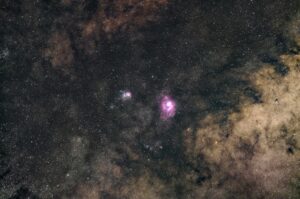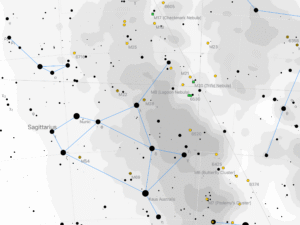An irregular dwarf galaxy
Lagoon and Trifid Nebulae
The Lagoon Nebula (Messier 8) is a vast interstellar cloud located about 4,100 light-years from Earth in the constellation Sagittarius. It is a giant emission nebula, spanning about 110 light-years across, and is notable for its brilliant pinkish-red hue due to ionized hydrogen gas. The Lagoon Nebula is an active stellar nursery, where new stars are constantly forming. Its most prominent feature is the dark, twisting lane of interstellar dust that cuts through its glowing center, creating striking contrasts against the bright background.
The Trifid Nebula (Messier 20), situated near the Lagoon Nebula in the same constellation, is a fascinating combination of emission, reflection, and dark nebulae. It lies approximately 5,200 light-years from Earth and is easily identifiable by its distinctive three-lobed appearance, which results from dark dust lanes that divide its bright, colorful regions. The red sections are areas of ionized hydrogen gas, while the blue areas reflect starlight from young, hot stars. This nebula is also a site of active star formation, with dense knots of gas and dust collapsing under gravity to form new stars.

Although both nebulae are part of the Milky Way’s rich tapestry, they exhibit unique characteristics that make them standout targets for astronomers and astrophotographers. The Lagoon Nebula’s vast, bright expanse and intricate dust structures contrast with the Trifid Nebula’s colorful, segmented appearance and complex interplay of emission and reflection zones. Together, they offer a vivid glimpse into the dynamic processes of star birth and the diverse structures within our galaxy.
Nikon D750 at 200 mm on Star Adventurer GTi
Wisconsin, United States
